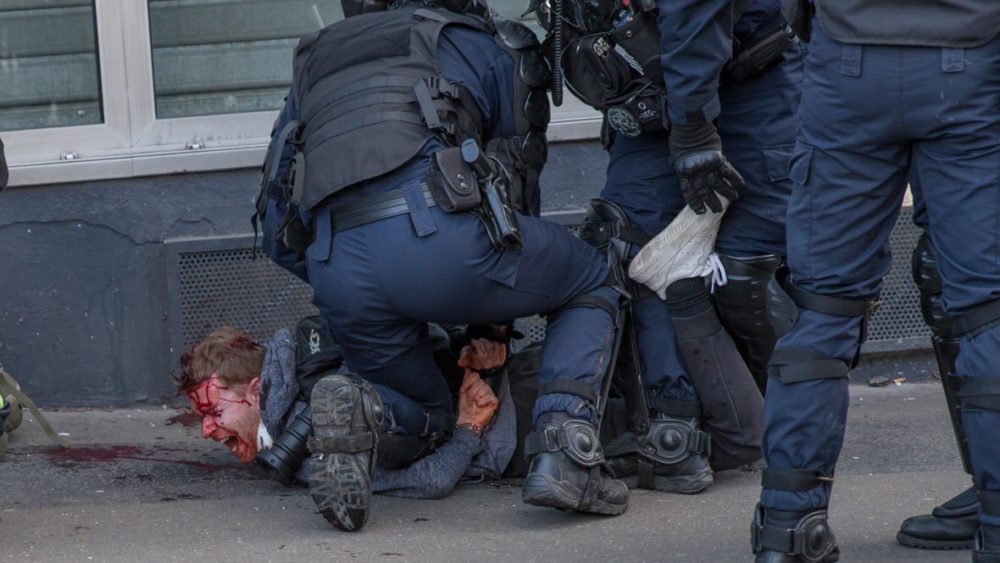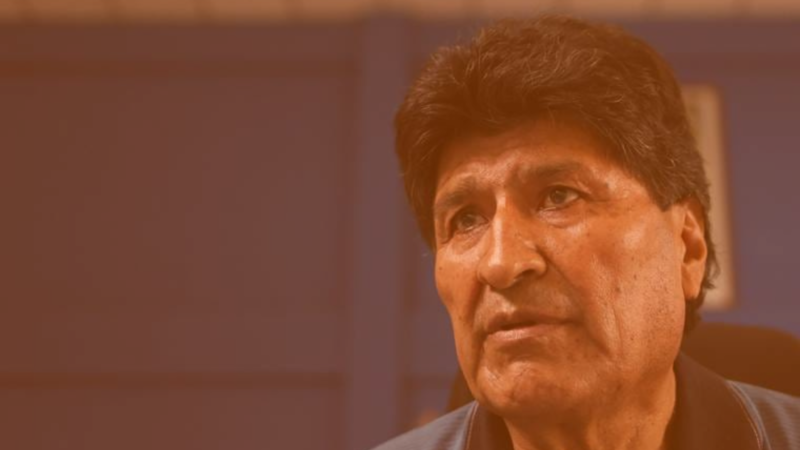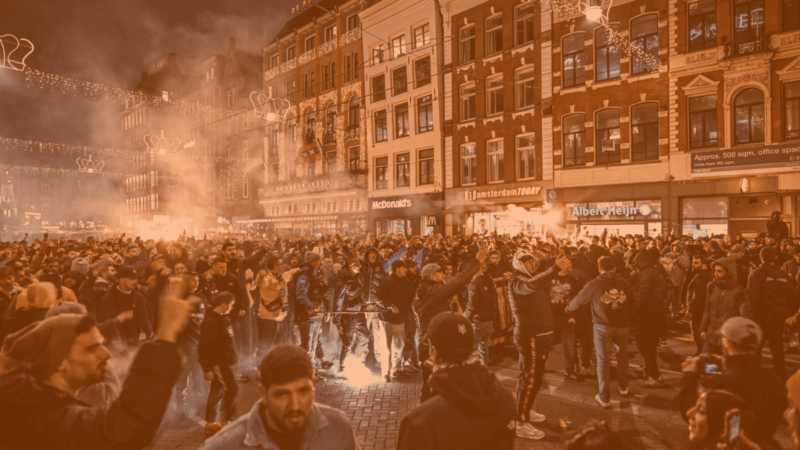On January 30, 2019, already one year ago, the Council of Europe, through its Commissioner for Human Rights, expressed “very serious concerns” about the seriousness of the injuries caused by the French police forces to the Gilets Jaunes (the Yellow Vests). Later in February 2019, the European Parliament and the UN strongly condemned the disproportionate use of police violence in France.
What about one year later, on the 51st day of protests involving members of almost all professions (nurses, electricians, lawyers, doctors, teachers, university professors and researchers, dockers, sewer workers, gas workers, train drivers, subway drivers, radiologists, postmen, labour inspectors, etc) against the neo-liberal measures of Emmanuel Macron’s government?
One year later the picture is frightening, a fortiori in a democracy.
- Three deaths: an old lady targeted at her window by a grenade; a young man pushed into the Loire River and not saved from drowning by the police forces in attendance, who themselves have hidden the fact for weeks; and a man pinned to the ground, whose larynx was broken and died suffocating during an identity check no later than ten days ago, whereas this method of arrest is prohibited in LA and NY and in entire Europe);
- Thirty five people have been blinded by being shot with “flashbang grenades”;
- The hands of five protesters have been torn by explosive grenades;
- 318 severe head injuries have been sustained by protesters;
- An estimated 6,000 persons have been injured.
Over the past two years, the Ministry of Interior Affairs order, roughly every six months, around 40,000 grenades that can be fired at 472kph (category A2 war weapons), thousands of single-shot and semi-automatic flashball launchers (banned in all democratic countries, yet in France around 13,000 shots were fired alone in 2019), tear gas launchers and more recently 25 million assault rifle bullets.
In Paris, armoured vehicles are being deployed, whilst hundreds of police motorcyclists, each with a driver and a passenger carrying a bat, are utilised to “accompany” demonstrators every week; where in fact the purpose is to assault people.
France is at war. No! Macron’s government is at war with its citizens.
Worse still, over the last twelve months the policy of the Ministry of Interior Affairs has dramatically changed. Since 1968, police prefects have been instructed to avoid direct contact with and injuries to demonstrators. Defend but never attack (“to hit a demonstrator on the ground is to hit yourself“). Dispersal was done at a distance.
In the past year direct contact and physical repression have been encouraged, applied by self-constrained police forces pushed to the limit due to lack of leave and overtime. Every day shows a new escalation in the violence. By law, police and gendarmerie have a legal monopoly on violence; provided that, violence is: (a) duly authorised by the hierarchy, (b) objectively justified; (c) proportional to the danger; and (d) defensive in nature.
In the past year, the use of violence has been applied outside these parameters i.e. illegally. It has been applied in a systematically and massively disproportionate and aggressive manner in demonstrations as denounced by international organisations. Where the rule of law is scorned, democracy disappears.
New methods are also now being devised and used against the public during demonstrations and strikes: for example, the use of drones, sophisticated video equipment and undercover police officers infiltrating groups of demonstrators at times even disguised as “black blocs”.
Preventive arrests of people with, for example, more than one yellow vest in their car have now become commonplace. Searches without just cause are now everyday events. Humiliations, insults and provocation by the police as witnessed by French DIEM25 members are the order of the day!
New laws have come into force allowing people to be banned from large geographical areas and for long periods of time in order to avoid demonstrations. The new crime of wearing balaclavas during demonstrations has been rolled out, punishable with jail sentences of up to one year and fines of up to €15,000. Meanwhile, the police has itself ordered 80,000 balaclavas for its own officers in order that they may not to be recognised by demonstrators (presumably to also protect the identity of policemen applying undue violence against members of the public).
An actual system has been implemented unworthy of any democracy. Welcome to the “land of human rights” as Macron once named France!
Calls for the resignation of the Minister of the Interior and the government have multiplied over the past year, coming from politicians, regular citizens, ophthalmologists, human rights organisations. But the government is instead increasing the repression – including against children, disabled persons and elderly people. Police forces are being encouraged by their hierarchy to lodge complaints against demonstrators in an effort to intimidate them.
The notorious case of a disabled lady in a wheelchair in Toulouse accused by the police of having attacked its officers during a demonstration shows how ridiculously far the situation has reached. The authority in charge of investigating violence and crimes of the French police forces against citizens (the IGPN) is part of the Ministry of Interior Affairs. Unsurprisingly, the IGPN has never found sufficient evidence of illegal action by any police force against its citizens.
Fortunately, more and more people are filming the actions of police forces around France and posting them on social networks. This is thus helping to combat against this strategy. Consequently, certain MPs of LREM, Macron’s political party, are now asking for a law to forbid the filming of police forces in action, a crime that would be punishable with a fine of €15,000.
The purpose of the government’s strategy is to scare citizens from demonstrating. The pictures of blinded Gilets Jaunes, both young and elderly, with bloodied skulls have produced the desired effect and lots of people are by now too scared to attend demonstrations or allow their family members on the streets.
By being unfamiliar with the exercise of power and obviously unaware of the determination of the French population, Macron has failed in his strategy.
French people have started to adopt other forms of protests: ballet dancers of the Paris Opéra have danced their anger on the external stairs of the opera house; the choir and the symphony orchestra of the state-owned radio unexpectedly started to perform Nabucco’s “Chorus of Slaves” during the new year wishes of their employers; protesting lawyers threw their black gowns at the feet of the Minister of Justice and have even began to regularly perform a New Zealand style hakka in public; teachers have built walls of class books blocking the entrance of the local LREM MPs’ offices; and last night citizens of French cities and big towns have organised torch lit processions to make it impossible for police forces to identify who and where to shoot.
Under pressure, cornered and worried for his reputation ahead of Davos, Macron recently indicated that the strategy currently being employed by the police will have to be modified by the Minister of Interior Affairs. Following this the minister immediately passed the blame to his police prefects (in particular to the zealous police prefect of Paris who was himself appointed by this same Minister of Interior Affairs after his predecessor had refused to make use of flashball launchers).
Will this have any consequences on our daily life?
Democracy is fragile. We, DIEM25, invite Europeans to stand up in solidarity with all citizens demonstrating for their rights. Wherever in the world. Sometimes this being surprisingly closer to home than our fellow Europeans might realise!
Do you want to be informed of DiEM25's actions? Sign up here










